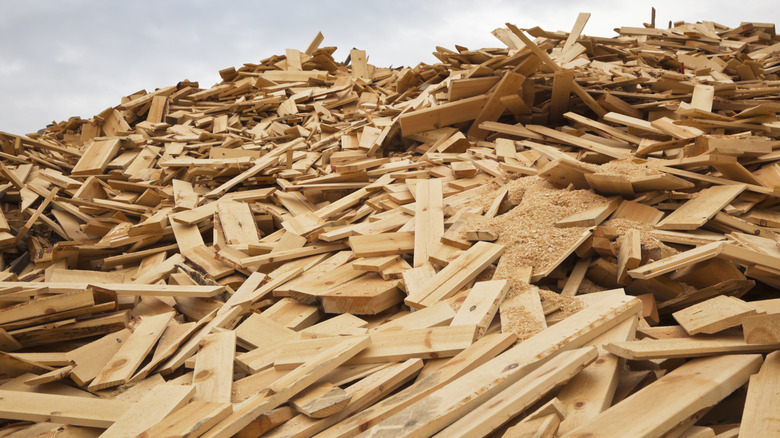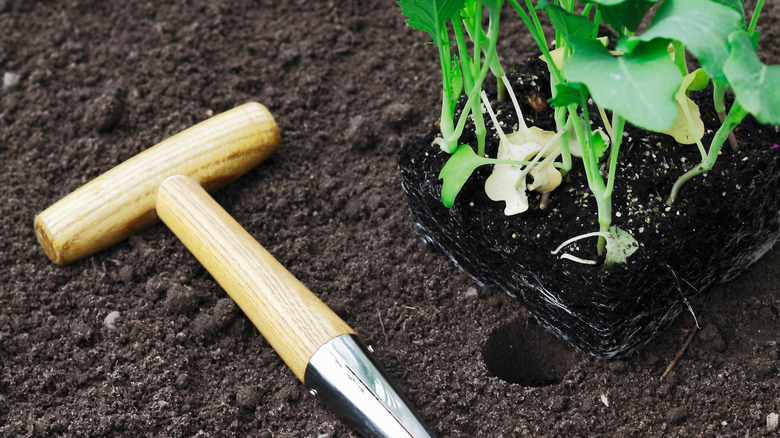How A Scrap Piece Of Wood Can Totally Up Your Gardening Game
When it comes to DIY life hacks in the garden, there is truly no end. However, this particular trick will make your life so much easier when repotting seedlings. If you've started anything from seed, you know how tedious it can be to repot your seedlings from 2-inch pots to 4-inch pots, 6-inch, and beyond. Well, if you have a scrap piece of wood lying around, you can carve it in the shape of a 2-inch pot so that when you go to pot up your seedling into a 4-inch pot, you can make the perfect indentation the size of the 2-inch pot so the seedling fits perfectly in the bigger pot with minimal effort.
This hack will undoubtedly up your gardening game and allow you to speed up the tedious process of repotting dozens of seedlings. This trend, presented by Epic Gardening on TikTok, has taken the gardening world by storm, and for good reason: It's an excellent time and energy-saving hack that will make your gardening life easier and allow you to focus on other gardening tasks. Not all of us have a green thumb. However, contrary to popular belief, a green thumb is not an innate quality that anyone is born with — it's a skill honed over time. There are some pretty awesome garden hacks that will instantly enhance your green thumb, and this scrap wood gardening hack is among them. While this hack is currently trending due to this video, it is actually an ancient tool dating back thousands of years that has helped make farmers' lives easier all over the world.
How this gardening hack works
This DIY gardening hack is pretty straightforward. Essentially, you want to find a scrap piece of wood and whittle it or carve it into the angled shape of a 2-inch pot. Then, after you fill your 4-inch pots with soil, you can easily press your new wooden tool into the middle of the 4-inch pot, making the perfect indentation for your seedling grown in a 2-inch pot. Next, after carefully removing your 2-inch potted seedling from the pot, place it into the indentation you just made in the 4-inch pot. It should fit like a jigsaw puzzle.
If you don't have scrap wood lying around, you can apply this concept to any material, as long as it is in the general shape and size of a 2-inch pot. Ever broken a gardening tool? The end of a shovel or any tool attached to a wooden handle works just as well. Of course, if you want to get real accurate with it, it helps to carve an angle into the wooden stick to best mimic the shape of the 2-inch pot. However, this is not necessary. Whether you start seeds indoors or outdoors, this is an excellent method to speed up the transplanting process. However, this gardening hack is by no means a new invention and actually has an ancient history.
The unknown history behind this gardening hack
The above TikTok video may give the impression that the creator invented this concept. However, agricultural history begs to differ. Historical accounts show that this idea is actually ancient and not a recent gardening hack at all. In fact, there is an established name for this tool: the dibbler or dibber, and its usage dates back as far as the Roman Empire. The development of agriculture began about 12,000 years ago, and since that time, humans have been strategizing on ways to make planting seeds easier. Thus, the dibbler was created, in addition to numerous other devices. As they say, necessity is the mother of invention, and our farming ancestors were looking for ways to improve handseeding. The dibble, dibbler, or dibber all refer to the same thing and have the same historical use: streamlining hand seeding.
Beginning as a stick or stake and used to poke a hole into the ground, during the 16th and 17th centuries in Europe, it was developed to be a hand tool at different lengths, suitable for gardening or large-scale agricultural use. It has evolved over the years to accommodate different needs and applications, but what remains abundantly clear is its effectiveness and use in the garden. While the creator of the above TikTok video may or may not be aware that dibbers or dibblers exist, he followed his instincts and created a useful and ancient tool out of necessity, just like our farming ancestors.

